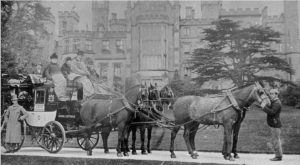Park Drag or Private coach
Description

Coach service at Alton Towers. The 20th Earl of Shrewsbury in the driving seat of his 'Greyhound' coach, in front of Alton Towers, one of his family homes and where the Earl ran the daily coach service to Buxton. This image is included by kind permission of the Churnet Valley Railway.
The Private Coach, also known as a Park Drag, was a privately owned version of public stage coaches and mail coaches.
This drag was built in the early 19th century for the Earls of Shrewsbury by Holland and Holland. The 20th Earl was an enthusiastic and successful driver and this may well be the vehicle in which he drove a record 121 miles in one day in 1887! He also often drove a regular Greyhound coach service between Alton and Buxton in 1892 and 1893. It was unusual for the owner to drive a private coach rather than the coachman.
This coach has sockets at the end of the roof seats and footboards which were probably used for securing a sun awning when it was being used as a grandstand. It also has staples for a luncheon box, sometimes called an imperial, to be mounted on the roof.
The Coach was repainted in its current colours in the 1980s. Originally, it would have been red, blue and black.
Accession Number: 64.064.0002
Additional information
During the late 18th Century mail and passengers were transported by a wide variety of coaches. They were usually brightly painted and carried between four and twelve passengers on top! Later a legal safety limit was introduced allowing not more than three outside passengers.
By 1835 700 standard mail coaches were in operation, all painted in black and maroon livery and bearing the royal cipher and route number. However the development of the railway network marked the end of this form of public transport. The last mail coach ran in the 1870s.
All through the 19th Century the private driving of coaches was a popular sport for wealthy gentlemen. The first driving club was founded in 1807 and several others followed. The design of the Private Coach was similar to that of public coaches but arranged to carry fewer passengers and usually incorporated a picnic hamper and table in place of the boot. Their height made them ideal grandstands at race meetings and other sporting events.
